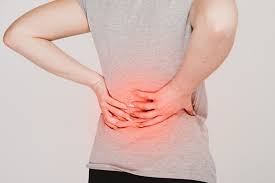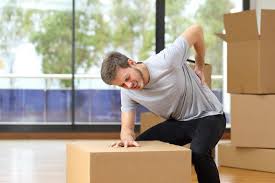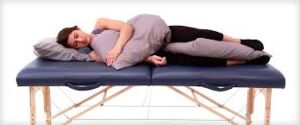Back Pain Relief: Understanding Causes, Symptoms & Treatment
Back pain is a common health problem that can be quite debilitating and cause significant disruptions in daily life. This type of pain can range from mild discomfort to severe agony and can often become chronic if left untreated for long periods of time. Back pain affects people of all ages, genders, and activity levels. It can be caused by injuries, poor posture, or wear and tear on the spine due to aging; however, many cases are idiopathic, meaning the exact cause is unknown. Treatment options vary depending on the severity of the back pain, but usually involve physical therapy, lifestyle modifications such as exercise and weight loss, rest and relaxation techniques, medications to reduce inflammation and swelling, or even surgery in more extreme cases. Please keep reading for details on the following topics:
Risk factors of back pain
Causes of back pain
Symptoms of back pain
How to check the spine’s alignment
How back pain is investigated
When to seek urgent medical care
What to do immediately after incurring pain to the back
How to manage back pain
The correct way to lift objects
Exercises to rejuvenate sore muscles
Helpful tips to remember
Good sleeping habits
How to practice good posture
Best foods to eat for the bones
Foods to avoid

The back refers to the posterior part of the human body, extending from the neck to the pelvis. It includes the spinal column, which consists of vertebrae, discs, and nerves. Muscles, ligaments, and tendons support the spine and facilitate movement. The back plays a crucial role in providing structural support, protecting the spinal cord, and enabling various bodily movements such as bending, twisting, and lifting. It also houses vital organs and is essential for maintaining posture and balance.
The risk factors of back pain include:
- Sedentary lifestyle
- Overweight or obesity
- Aging
- Smoking
- Genetics
- Strenuous physical activity or heavy lifting
- Poor posture
- Certain medical conditions such as arthritis or osteoporosis
- Pregnancy
- Engaging in activities that involve repetitive or awkward movements, such as bending or twisting
- Occupational factors, such as sitting or standing for prolonged periods without proper ergonomics or breaks.
The causes of back pain can vary widely and may include:
- Poor posture
- Improper bending and lifting techniques
- Pregnancy
- Dehydration
- Overweight or obesity
- Serious medical conditions such as herniated discs or spinal stenosis
- Strain to the muscles or ligaments due to overexertion or sudden movements
- Issues with the spinal discs, such as degeneration or herniation
- Arthritis
- Weakening of the bones, such as osteoporosis
- Improper footwear
- Prolonged standing or sitting in one position
- Traumatic events such as falls or accidents.
Symptoms of back pain can vary depending on the underlying cause, but they may include:
- Pain in the back, ranging from mild to severe
- Tenderness or soreness in the affected area
- Muscle cramps or spasms
- Weakness in the muscles of the back or legs
- Fatigue or exhaustion
- Loss of weight, especially if accompanied by appetite changes
- Fever, which may indicate an infection
- Pain that radiates down the leg, known as sciatica
- Numbness or tingling in the buttocks or legs
- Difficulty urinating or having a bowel movement, which may indicate nerve compression or other serious issues.
To check the spine’s alignment, you can follow these steps:
- Stand up straight with your back against a wall, ensuring that your feet are shoulder-width apart.
- Make sure your head, shoulders, buttocks, calves, and heels are all touching the wall.
- Slide your hand between the wall and the lower back.
- Your lower back should have a slight curve, with enough space to fit your hand comfortably.
- If there is too much space or if your back is pressed flat against the wall, it may indicate misalignment.
- You can also have a healthcare professional assess your spine’s alignment through physical examination or imaging tests like X-rays or MRI scans if needed.
Back pain is investigated through various methods, which may include:
- X-rays: X-rays can reveal whether the cause of the pain is related to issues like fractures, degenerative changes, or abnormalities in the bones and joints.
- MRI (Magnetic Resonance Imaging) and CT (Computed Tomography) scans: These imaging tests provide detailed pictures of the spine, allowing healthcare providers to assess the condition of the discs, nerves, muscles, ligaments, and other soft tissues. They can detect problems such as herniated discs, spinal stenosis, tumors, or infections.
- Blood tests: may be conducted to check for signs of infection or inflammation, as well as other systemic conditions that could be contributing to the back pain.
- Nerve tests: Electromyography (EMG) and nerve conduction studies may be performed to evaluate nerve function and detect any abnormalities or damage.
- Physical examination: A thorough physical examination by a healthcare provider may include assessing posture, range of motion, muscle strength, reflexes, and sensation. This can help identify areas of tenderness, muscle spasms, or neurological deficits.
-
History and symptoms review: Healthcare providers will also discuss the patient’s medical history, including any previous injuries, surgeries, or underlying health conditions, as well as the specific characteristics of the back pain (e.g., location, severity, duration, aggravating factors).
What to do immediately after incurring pain to the back
After experiencing back pain, it’s important to take some immediate steps to help alleviate discomfort and promote healing. Here’s what you can do:
- Apply ice: Use an ice pack or a bag of frozen vegetables wrapped in a towel and apply it to the painful area for 20 minutes every 2 hours for the first couple of days. Cold therapy helps numb the pain, reduce inflammation, and minimize swelling.
- Rest: Avoid strenuous activities and give your back time to rest and recover. Limit activities that exacerbate the pain but try to remain as mobile as possible to prevent stiffness and muscle weakness.
- Avoid heat initially: While heat can help relax muscles and alleviate pain, it’s generally recommended to wait at least 48 hours before applying heat to the affected area. Heat can increase inflammation and worsen swelling during the acute phase of injury.
- Gentle movement: Perform gentle movements or stretches that don’t exacerbate the pain. Avoid sudden movements or activities that put strain on the back. Gradually increase your range of motion as pain decreases and mobility improves.
- Over-the-counter pain relief: Consider taking over-the-counter pain medications such as ibuprofen (Advil, Motrin) or acetaminophen (Tylenol) to help reduce pain and inflammation. Follow the recommended dosage instructions and consult with a healthcare professional if you have any concerns.
- Maintain good posture: Pay attention to your posture when sitting, standing, and walking to avoid putting additional stress on your back. Use supportive chairs with proper lumbar support and avoid slouching.
- Seek medical advice if needed: If the pain persists or worsens despite home remedies, or if you experience any concerning symptoms such as numbness, weakness, or loss of bladder or bowel control, consult a healthcare professional for further evaluation and appropriate treatment.
Remember to listen to your body and avoid activities that exacerbate the pain. If you’re unsure about the severity of your condition or the appropriate course of action, it’s always best to seek guidance from a healthcare professional.
How to manage back pain

Managing back pain involves a combination of self-care strategies, lifestyle modifications, and medical interventions. Here are some ways to manage back pain effectively:
- Avoid aggravating activities: Identify activities that may cause injury to the back or movements that worsen your back pain and avoid them. This may include heavy lifting, prolonged sitting or standing, or high-impact exercises. Maintain proper body mechanics when lifting and bending.
- Medications: Over-the-counter pain relievers such as ibuprofen (Advil, Motrin) or acetaminophen (Tylenol) can help alleviate pain and reduce inflammation. Prescription medications such as muscle relaxants or anti-inflammatory drugs may be prescribed by a healthcare professional for more severe pain.
- Physical therapy: A physical therapist can design a personalized exercise program to strengthen the muscles supporting your spine, improve flexibility, and alleviate pain. They may also incorporate techniques such as massage, acupuncture, heat or cold therapy, and electrical stimulation.
- Mind-body techniques: Practices such as yoga, tai chi, and meditation can help reduce stress, improve posture, and alleviate back pain by promoting relaxation and mindfulness.
- Heat and cold therapy: Applying heat packs or warm baths can help relax tense muscles and increase blood flow to the affected area, while cold packs can reduce inflammation and numb pain. Alternate between heat and cold therapy as needed.
- Supportive footwear: Wearing supportive shoes with cushioned soles and good arch support can help reduce strain on your back, especially if you spend long periods standing or walking.
- Weight management: Maintaining a healthy weight reduces strain on your spine and joints, which can help alleviate back pain. Follow a balanced diet rich in fruits, vegetables, lean proteins, and whole grains to support overall health.
- Improving posture: Practice good posture habits, such as sitting up straight, keeping your shoulders back, and avoiding slouching. Use ergonomic chairs and supportive pillows to maintain proper alignment while sitting or sleeping.
- Stress management: Stress and tension can contribute to muscle tightness and exacerbate back pain. Find healthy ways to manage stress, such as relaxation techniques, deep breathing exercises, or engaging in enjoyable activities.
- Stay active: While rest is important during the acute phase of back pain, staying physically active can help prevent stiffness and muscle weakness in the long term. Incorporate gentle exercises such as walking, swimming, or yoga into your routine, gradually increasing intensity as tolerated.
- Nutrition: Ensure a balanced diet with adequate vitamin D and hydration to support bone health and muscle function
- Professional interventions: In some cases, medical interventions such as corticosteroid injections, nerve blocks, or surgery may be necessary to treat underlying structural issues causing back pain. Consult with a healthcare professional to determine the most appropriate treatment options for your specific condition.
- Warm-up: Perform warm-up exercises before engaging in strenuous physical activity to prepare muscles and prevent injury.
- Topical treatments: Consider using topical products containing hot pepper or other pain-relieving ingredients to alleviate discomfort.
- Bedding: Ensure your mattress and bed frame provide adequate support to promote spinal alignment and reduce discomfort during sleep.
How to lift objects
Proper lifting technique is essential for preventing back injuries and reducing the risk of back pain. Here’s how to lift objects safely:
- Plan ahead: Assess the object you intend to lift. Determine its weight and whether you can lift it safely on your own.
- Position yourself: Stand close to the object with your feet shoulder-width apart. Position one foot slightly in front of the other for stability.
- Bend your knees: Keep your back straight and bend your knees to lower yourself down to the object. Avoid bending at the waist.
- Maintain a good grip: Use both hands to grasp the object firmly. If possible, use handles or grip aids to improve your grip.
- Lift with your legs: As you begin to lift the object, use your leg muscles to power the movement. Keep your back straight and avoid twisting or turning while lifting.
- Keep the object close to your body: Hold the object securely against your body as you lift it. This helps distribute the weight evenly and reduces strain on your back.
- Avoid sudden movements: Lift the object smoothly and steadily, without jerking or pulling. Use controlled movements to maintain stability.
- Use your core muscles: Engage your abdominal muscles to support your lower back as you lift and carry the object.
- Avoid lifting heavy objects above shoulder height: If you need to lift something overhead, use a stable platform or step stool to bring the object to a more manageable height before lifting.
-
Ask for help if needed: If an object is too heavy or awkward to lift safely on your own, don’t hesitate to ask for assistance from a coworker, friend, or family member.
Exercises to rejuvenate sore muscles

Here are some gentle exercises that can help rejuvenate sore muscles in the back:
- Cat-Cow Stretch:
- Start on your hands and knees with your wrists directly under your shoulders and your knees under your hips.
- Inhale as you arch your back, dropping your belly towards the floor and lifting your head and tailbone towards the ceiling (Cow Pose).
- Exhale as you round your back, tucking your chin towards your chest and arching your spine towards the ceiling (Cat Pose).
- Repeat this sequence, moving smoothly between Cow and Cat poses for several repetitions.
- Child’s Pose:
- Begin on your hands and knees with your wrists under your shoulders and your knees wider than hip-width apart.
- Sit back on your heels, lowering your chest towards the floor and extending your arms forward.
- Rest your forehead on the mat and breathe deeply, focusing on relaxing the muscles of your back and shoulders.
- Pelvic Tilts:
- Lie on your back with your knees bent and your feet flat on the floor.
- Engage your abdominal muscles and gently tilt your pelvis towards your chest, flattening your lower back against the floor.
- Hold for a few seconds, then release and allow your lower back to return to its natural curve.
- Repeat several times, moving slowly and mindfully.
- Seated Spinal Twist:
- Sit on the floor with your legs extended in front of you.
- Bend your right knee and place your right foot on the outside of your left knee.
- Place your left hand on your right knee and your right hand behind you for support.
- Inhale to lengthen your spine, then exhale as you gently twist towards the right, looking over your right shoulder.
- Hold for several breaths, then return to center and repeat on the opposite side.
- Hamstring Stretch:
- Lie on your back with one leg bent and the foot flat on the floor, and the other leg extended straight up towards the ceiling.
- Hold the back of your thigh or calf with both hands and gently pull the leg towards you until you feel a stretch in the back of your thigh.
- Hold the stretch for 20-30 seconds, then switch legs and repeat.
-
Low Back Stretch:
- Lie on your back with your knees bent and feet flat on the floor.
- Cross your right ankle over your left knee, creating a figure-four shape with your legs.
- Reach your hands around your left thigh and pull it towards your chest until you feel a stretch in your right hip and lower back.
- Hold the stretch for 20-30 seconds, then switch legs and repeat.
Remember
Here are some important safety reminders to accompany those exercises:
- Consult with a medical professional: Before attempting any exercises, especially if you have pre-existing medical conditions or are experiencing significant back pain, it’s crucial to consult with a licensed medical practitioner or physical therapist. They can provide personalized recommendations based on your specific situation.
- Listen to your body: If you feel any pain or discomfort while performing an exercise, stop immediately. Pain is your body’s way of signaling that something isn’t right, so it’s important to listen to these signals and avoid activities that exacerbate your symptoms.
- Seek medical attention if needed: If you experience severe or persistent pain, numbness, tingling, weakness, or any other concerning symptoms during or after exercising, seek urgent medical care. These could be signs of a more serious underlying issue that requires prompt evaluation and treatment.
- Modify exercises as needed: Not all exercises are suitable for everyone, and some may need to be modified based on individual limitations or restrictions. A physical therapist or qualified fitness professional can help you adapt exercises to your specific needs and abilities.
-
Gradually increase intensity: If you’re recovering from back pain or injury, start with gentle, low-impact exercises and gradually increase intensity and duration as tolerated. Pushing yourself too hard or too soon can lead to further injury and setbacks.
These instructions are helpful tips for maintaining proper posture and reducing strain on the back, especially while lying down and getting up from bed:

- Tuck a pillow under the knees when laying down on the back: Placing a pillow under the knees while lying on your back helps to maintain the natural curvature of the spine and reduces pressure on the lower back.
- Tuck a pillow between the knees when laying on the side: Similarly, placing a pillow between the knees while lying on your side helps to align the spine, hips, and pelvis, reducing strain on the lower back and promoting spinal alignment.
- Avoid laying on the stomach for prolonged periods: Lying on the stomach can cause excessive strain on the lower back and neck, as it flattens the natural curve of the spine. It’s best to avoid this position or limit the time spent in it.
-
When getting up: These steps describe a safe method for getting up from lying down:
a. Roll onto the side: Turn onto your side, keeping your knees bent.
b. Swing the legs over the edge of the bed: Gently lower your legs over the edge of the bed while maintaining the side-lying position.
c. Use the free arm to push the body into a sitting position: Use your arm that is not supporting your body weight to push yourself up into a sitting position.
Best foods nutrients for maintaining muscle tone, skeletal alignment, and preventing cramps:
-
Carbohydrates, vitamins, and minerals for muscle tone and strength: Carbohydrates provide energy for muscle function, while vitamins and minerals such as vitamin C, vitamin E, potassium, and magnesium support muscle health and function. Adequate intake of these nutrients helps maintain muscle tone and strength, supporting overall physical performance and preventing muscle weakness.
- Calcium, phosphorus, and magnesium for proper skeletal alignment: Calcium, phosphorus, and magnesium are essential minerals for bone health. They contribute to bone density, strength, and proper alignment of the skeletal system. Adequate intake of these minerals through diet or supplements helps maintain strong and healthy bones, reducing the risk of fractures and skeletal misalignment.
-
Vitamin B for preventing cramps: Vitamin B complex, including B1 (thiamine), B6 (pyridoxine), and B12 (cobalamin), plays a role in nerve function and muscle contraction. Adequate intake of these vitamins helps prevent muscle cramps and spasms by supporting proper nerve signaling and muscle function.
- Uric acid and joint health: High levels of uric acid can lead to inflammation and joint deterioration, contributing to conditions like gout and arthritis. Managing uric acid levels through dietary changes, such as reducing intake of purine-rich foods like red meat, organ meats, and certain seafood, can help alleviate symptoms and promote joint health.
- Excess salt, protein, and coffee and bone health: Consuming excessive amounts of salt, protein, and caffeine (found in coffee) can increase calcium excretion from the body, potentially weakening bones over time. To support bone health, it’s advisable to moderate intake of these substances and focus on a balanced diet rich in calcium, vitamin D, and other nutrients essential for bone strength.
- Adding vitamin D for pain, cramps, and bone health: Vitamin D plays a crucial role in calcium absorption and bone mineralization, helping to maintain bone density and prevent conditions like osteoporosis. Including vitamin D-rich foods in the diet, such as fatty fish, fortified dairy products, and egg yolks, or taking vitamin D supplements as recommended by a healthcare professional, can support overall bone health and alleviate symptoms like pain, cramps, and muscle weakness.
-
Mustard and pickles for cramp relief: Mustard and pickles contain vinegar, which may help alleviate muscle cramps due to their acetic acid content. While individual responses may vary, incorporating these foods in moderation as part of a balanced diet may provide relief from muscle cramps for some individuals.
When to seek urgent medical care
It is important to know when to seek urgent medical care, as delaying appropriate treatment can lead to further health complications. If you experience any of the following symptoms, you should seek medical help immediately. If you have any doubts about whether you should seek medical care, it is always better to err on the side of caution and consult with your doctor.
- Severe pain in the back that is unrelenting or worsens over time.
- Inability to move or control movement in the back or legs.
- Pain that radiates down one or both legs, especially if accompanied by numbness, tingling, or weakness.
- Back pain that occurs at night or when lying down and is not relieved by changes in position.
- Loss of control of bladder or bowel function, such as difficulty urinating or defecating, or loss of sensation in the genital area.
- Sudden unexplained weight loss.
- Persistent back pain that lasts for more than two weeks despite conservative treatments or rest.
- Fever, especially if accompanied by back pain, which could indicate an infection.
- Back pain following a fall, trauma, or blow to the back.
- History of cancer or recent infection, as back pain could be a sign of metastasis or spinal abscess.
Disclaimer: The information provided in this content is for general informational purposes only. It is not intended as medical or healthcare advice, diagnosis, or treatment. Always seek the advice of a qualified healthcare professional with any questions you may have regarding a medical condition or healthcare decisions.

